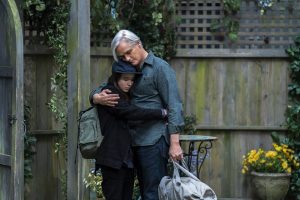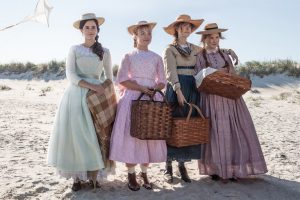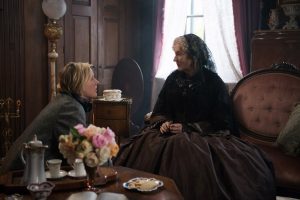Okay. Let me just preface this by reminding you that yesterday, when I discussed my overall feelings toward Toy Story 4, I had basically no clue what to say – my mind was still reeling from what I had just seen, and the emotions were still too near, too raw.
Now, I’ve had a chance to think over everything that happened in the movie, and I think I can put into words what I was attempting to explain yesterday – at the very least, I’ll try, and we’ll see how it goes. This is a SPOILER REVIEW, which will make it much easier for me to discuss certain things (obviously), but if you don’t want to know anything about Toy Story 4 I urge you to leave now.
And for those of you who have seen the film already (or simply don’t care about spoilers), then let’s hop on this merry-go-round – sorry, carousel – of emotions.
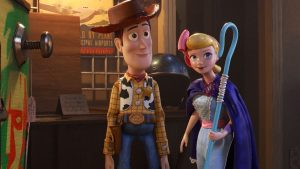
First, let’s just discuss one of the overwhelmingly positive things about the movie: the story itself. Never has a Toy Story movie felt so deep and complex, with so much richness of detail – except maybe Toy Story 2, still my favorite of the franchise and the only one that, in my opinion, perfectly balanced the arcs of our main characters, who were Woody, Buzz and Jessie at the time. Introducing Bo Peep to the story in Toy Story 4 adds a large complexity to this film, as the story has to work overtime to establish her as a character, since – well, she really wasn’t one in Toy Story or Toy Story 2, and she wasn’t even present in Toy Story 3. So this film does have an issue sometimes while juggling the stories of four main leads – but we’ll get to that. Leaving them aside, the plot itself is an intricate web, with a good balance of comedic and dramatic moments: it even turns into an elegant film-noir suspense thriller when our antagonist, Gabby Gabby (Christina Hendricks), enters the picture. One thing I didn’t understand while watching the movie and still don’t understand now is Pixar president Jim Morris’ claim that Toy Story 4 is a “romantic comedy” – I mean, sure, the love story of Woody (Tom Hanks) and Bo Peep (Annie Potts) plays a large part, and tries hard to look like the defining factor in Woody’s eventual decision to leave behind his life as a toy – but it really isn’t. It was inevitable from the movie’s first few scenes that Woody had no reason to stay with his new child owner, Bonnie – he was constantly reminiscing about his better days with Andy, and some of the other toys, specifically Dolly (Bonnie Hunt), were treating him like worthless garbage. The romance only gives Woody additional motivation to leave. So, if anything, the movie feels most like a feel-good motivational film about learning self-value.
A really hilarious one, though: I have no qualms about admitting that Toy Story 4 is easily the funniest entry in the franchise, with a large assortment of brilliant one-liners and running gags – many of them packed into the last twenty minutes of the movie, as Buzz Lightyear (Tim Allen), Jessie (Joan Cusack), Trixie (Kristen Schaal), and Forky (Tony Hale) team up to try and stop Bonnie’s family from leaving in their RV: what starts out with Jessie merely puncturing the vehicle’s tires and Buzz causing a humorous distraction turns into hysterical comedy when Trixie sabotages the GPS and starts trying to lead the family back to the fairground where they left Woody – “Right! Another right! RIGHT!”, while Buttercup (Jeff Garlin) frantically tries to help by grabbing hold of the accelerator. Eventually cops start trailing the erratic RV, and Forky even locks Bonnie’s dad out of the car – and somehow Bonnie sleeps through all of this. I gotta say, I really felt for Bonnie’s parents in this movie: not only did they have to handle one very hyper and very forgetful child (literally, I lost count of how many times she misplaces her backpack in this movie), but their weekend vacation turned really stressful, really fast. No fault of their own, of course.
But I have to admit, I cracked up when the RV finally ground to a halt at its (a.k.a the toys’) destination, and Buttercup exclaimed “Dad’s totally going to jail now!”.
Just as funny, if not funnier, is the addition of Ducky (Keegan-Michael Key) and Bunny (Jordan Peele) to the Toy Story universe: two lovable plush toys with big egos and laser eyes (no, really!), their back-and-forth repertoire is one of the movie’s highlights – their best running joke is one that we glimpsed a part of in the final trailer, where they attack an elderly lady: as I suspected, this scenario is merely a hypothetical, but it’s actually just one in a long list of different ideas that the duo come up with in order to take an important key from the woman. The other battle-plans that they propose get funnier and funnier, until we culminate in the ultimate horror parody – where we watch the woman lock up shop for the night, drive home down lonely country lanes, eat dinner, take a bath, and settle into bed, all set to some quaint, foreboding music, only to have Ducky and Bunny rise above her pillow as she sleeps – which cuts away as we hear the woman scream in terror. “Yeah, we’re not doing that,” Buzz declares. In the end, they manage to get the key by pure luck, as the woman happens to set it down on the shelf right next to them, but the “ol’ plush rush”, as the fluffy toys call one of their more tame strategic maneuvers, is used twice more in the film: once to help a young child find her parents, and once during a mid-credits cut-scene where Ducky and Bunny imagine themselves terrorizing their human overlords and becoming gargantuan, unstoppable forces of apocalyptic power, equipped with laser eyes. All this is even funnier when you remember that Jordan Peele is a horror-film director himself, and these scenes act as gentle satire of his own preferred genre.
However, I did not expect the rest of the film to also adopt certain horror tropes – most notably with its host of absolutely terrifying ventriloquist dolls, and the scene where Woody wakes up after having his voice-box removed only to find one of these dolls staring down at him with a frightening smile. In fact, those dolls were everywhere – they were used for multiple jump-scare moments, including one in which an unsuspecting woman runs to grab an out-of-control baby-carriage, screaming when she discovers one of the puppets inside it. In fact, the humans of Toy Story were subjected to more unimaginable humiliations and nightmarish events than ever before in the franchise – even leaving aside the many times Ducky and Bunny wanted to burn them all, humans were manipulated, scared out of their minds and left heartbroken by toys in this movie. I felt devastated for one child, Harmony, when she took Woody with her to the park only to have him run away as soon as her back was turned – and then, of course, I hated Harmony when she threw away Gabby Gabby later in the film.
Honestly, Gabby Gabby is probably the franchise’s best villain ever – except for maybe, just maybe, Emperor Zurg from Toy Story 2, because he terrified me as a kid. In general, the new characters are all fantastic: Keanu Reeves’ Duke Caboom does a lot even with limited screentime; Forky is wonderful and must be protected at all costs – and his new girlfriend Knifey, who gets revealed during a mid-credits scene, looks fun too; there are even cameos from Mel Brooks, Carol Burnett and Carl Reiner, though far too brief to make much of an impression; and even Bo Peep’s sheep get personalities.
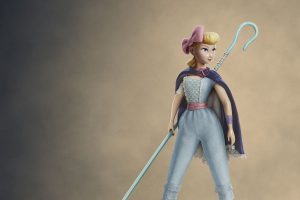
Unfortunately, the cast of characters has become so large that it would be impossible to give everyone the appreciation they deserve: Hamm, Rex, the Potato Heads, Slinky Dog and the iconic three-eyed aliens are all completely sidelined throughout the movie, given little or no dialogue (were the aliens even in the movie at all?), and any semblance of character arcs for them are nonexistent. I mean, I don’t know about you, but it makes me really angry that the aliens weren’t part of the film’s finale, as they were in Toy Story 3 – they’re iconic characters, unofficial mascots of the franchise.
I could even have forgiven that, though, if this hadn’t also happened to literally everyone not named Woody or Bo Peep. Buzz Lightyear and Jessie should have been crucial characters in this story’s plot – but the film only tries half-heartedly with Buzz, and it doesn’t even try at all with Jessie. Was I inordinately happy when Woody gave his Sheriff’s badge to Jessie at the end of the movie? Yes! But it felt like a poor attempt to make her seem important: in Toy Story 2, she was the heart and soul of the movie – but here, she was merely one face in an over-crowded ensemble that couldn’t even be bothered to give Buzz Lightyear a decent conclusion. Saying the oft-repeated catchphrase “To infinity and beyond” does not count, in my opinion. But Woody and Bo Peep, well, they got plenty of time to frolic around the fairground, chatting, laughing, and going to nightclubs – where Bo proceeded to treat Woody as her “accessory”.
If I may make a Marvel comparison here, I feel like Woody was both the Iron Man and the Captain America of Toy Story 4: Iron Man because he was constantly being treated poorly by everyone around him – and Captain America because, in the end, he chooses to go off and live the life he always wanted with Bo Peep, abandoning his own “no toy left behind” mantra, after passing on his responsibilities to Jessie. In which case Buzz is his Bucky, and in both cases neither friendship got to end with any sort of satisfying conclusion to years of emotional, important storytelling.
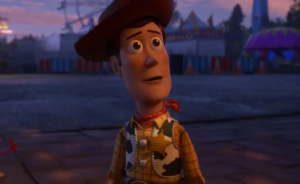
As you can probably guess, I’m a little conflicted about the ending: on the one hand, I knew it was coming and I appreciated its bravery. On the other hand, I expected Pixar to handle it a little less roughly and awkwardly than they did – maybe it’s because we did just see this sort of thing in Avengers: Endgame (stop cannibalizing your own movies, Disney!), or maybe it’s because I was dumbfounded while watching it, but it didn’t have the impact I expected it to; not because it didn’t make me cry (it did), but because it didn’t feel final to me. I don’t want this to be the ending – Jessie and Buzz didn’t even get proper character arcs! There were no aliens! There’s still so much story left to tell!
Even if it doesn’t involve Woody or Bo Peep, can’t we get a Toy Story 5 focused on the toys still living in Bonnie’s room? – but no, instead there’s a Bo Peep short film called “Lamp Life” on its way to Disney Plus, where we’ll probably learn more about her escape from the antique store and her acclimation to life as a lost toy. There is also apparently a series of short features about Forky (and presumably Knifey) arriving on the streaming platform as well, which, according to Tony Hale, should have room for tons of cameos from the original cast.
Forky and the Aliens, please?
